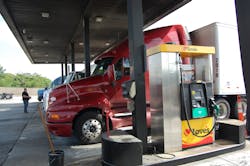Diesel and gasoline prices declined again this week in the U.S., according to data tracked by the Energy Information Administration (EIA); prompting a downward revision for U.S. fuel prices through 2015 in the agency’s latest Short Term Energy Outlook (STEO) report.
The national average retail pump price for diesel dropped 1.4 cents this week to $3.821 per gallon, EIA reported, which is 9.2 cents per gallon cheaper compared to the same week in 2013.
Diesel prices declined in every region of the country except for the Rocky Mountains, which witnessed a slight uptick of 2/10ths of a penny to $3.875 per gallon. Diesel prices dropped the most along the East Coast, the agency added, falling 2.5 cents to $3.935 per gallon in the Central Atlantic and 1.7 cents to $3.771 in the Lower Atlantic to generate a 2 cent decline in average East Coast diesel prices to $3.855 per gallon.
EIA noted that diesel exceeds the $4 per gallon mark only in California – down 2/10ths of a penny to $4.084 per gallon – and along the West Coast, where prices dropped 5/10ths of a penny to $4.010. The agency pointed out though that with California’s pricing removed from the mix, average diesel prices on the West Coast declined 9/10ths of a penny to $3.921 per gallon.
The national average retail pump price for gasoline declined 1.8 cents this week to $3.454 per gallon, EIA reported, which is 9.8 cents cheaper per gallon compared to the same week in 2013.
Gasoline prices only increased in the Midwest this week and only slightly – up 2/10ths of a penny to $3.397 per gallon – and declined across the rest of the nation, with gasoline prices falling the most in the Central Atlantic (down 3.5 cents to $3.456 per gallon), New England (down 3.4 cents to $3.546) and the East Coast (down 3.1 cents to $3.402).
Compared to 2013, however, gasoline prices in the Western U.S. are higher – particularly the Rocky Mountain region (up 2.9 cents per gallon versus last year) and the West Coast (up 8 cents per gallon versus 2013 and up 8.9 cents per gallon versus last year with California’s prices removed from the mix).
Still, EIA is now projecting lower average diesel and gasoline prices for the rest of 2014 and into 2015 based on recent trends.
The agency now expects that the monthly average regular gasoline retail price will fall from the recent peak of $3.69 per gallon in June to $3.50 in September, before falling to $3.30 in December. The U.S. annual average regular gasoline retail price, which averaged $3.51 per gallon in 2013, is projected to drop to $3.50 in 2014 and then fall to $3.46 in 2015.
Diesel fuel prices, which averaged $3.92 per gallon in 2013, are projected to fall to an average of $3.89 in 2014 – 4 cents lower than what EIA projected in July – then drop to $3.87 in 2015.
Those per-gallon price decreases are occurring despite a rise in U.S. fuels consumption – particularly for distillates, which includes diesel – that is being offset by an ongoing increase in domestic oil production that in turn is reducing oil imports.
EIA said gasoline consumption grew by 90,000 barrels per day (bbl/d) or 1.1% in 2013 – the largest annual increase since 2006 – with consumption predicted to increase by 40,000 bbl/d in 2014 before reversing course and falling 10,000 bbl/d in 2015 as improving fuel economy in new vehicles increasingly offsets highway travel growth.
Distillate fuel consumption – which includes diesel fuel – increased by 90,000 bbl/d or 2.5% in 2013 last year, reflecting colder weather and economic growth, and is projected to increase by a whopping 140,000 bbl/d in 2014 and 70,000 bbl/d in 2015, the agency said.
Yet EIA believes increases in total U.S. crude oil production -- rising from an estimated 7.5 million bbl/d in 2013 to 8.5 million bbl/d in 2014 and then 9.3 million bbl/d in 2015 – are helping keep motor fuel prices in check to a degree as that growth in domestic production is contributing to a significant decline in petroleum imports.
The share of total U.S. liquid fuels consumption met by net imports fell from 60% in 2005 to an average of 33% in 2013, EIA reported, and the agency now expects the net import share to decline to 22% in 2015, which would be the lowest level since 1970.
About the Author
Sean Kilcarr
Editor in Chief
Sean Kilcarr is a former longtime FleetOwner senior editor who wrote for the publication from 2000 to 2018. He served as editor-in-chief from 2017 to 2018.
